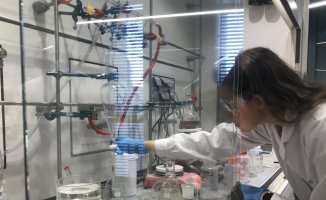Follow the vertigo. The evolution of GPT-3.5, the artificial intelligence language model that powered the ChatGPT bot is called GPT-4, and it is significantly more powerful than its predecessor in many tasks. One of its most impressive features is that it is a multimodal AI: it can work with text, image and sound, although the OpenAI company currently only allows access to textual chat to paid subscribers, to whom it opened its use yesterday.
To see some of its visual capabilities, the OpenAI development team showed in a video how GPT-4 was able to identify a web page sketch made with a few hand strokes on paper and perfectly write the HTML code that makes it. possible.
GPT-4's imaging skills are put to the test. One of those being tested is Be my eyes –be my eyes–, an application that allows the blind to receive accurate descriptions of anything within their reach thanks to the camera of their mobile phone.
The texts of GPT-4 are deeper than those of the previous version and its comprehension too. A devastating example is that, subjected to university law tests, the AI obtains a grade within the 10% of the best human students, when its predecessor was in the 10% of the worst. In all kinds of tests, the machine passes.
It's not that it's perfect. In fact, it suffers from some of the same problems that GPT 3.5 had. Not only can you make reasoning errors, but the authors point out that there are also ways to get around some of the stronger barriers that OpenAI has put up to prevent you from having certain biases.
In fact, they warn that as was the case with GPT-3.5, "it is still not totally reliable", since it is capable of "blundering with the facts and making errors of reasoning". "You have to be very careful when using the results of linguistic models, especially in high-risk contexts."
The arrival of the new model has caused quite a stir. You can write programming code with great fluency. Among the examples that appeared on social networks, it was possible to see that he is capable of programming simple video games in a few seconds, from Pong to Tetris, just by asking him in text form.
Microsoft, which has made the OpenAI AI one of its big bets, explained that the new Bing search engine that has been running for a few weeks already integrated GPT-4 from the beginning. Meanwhile, Google continues to test.
Alberto Romero, technology analyst and author of The Algorithmic Bridge , a newsletter specializing in artificial intelligence, points out that in GPT-4, "the most interesting thing about the future of AI is that it is multimodal and at the same time it is better in language than his predecessor”. He considers that, although "it is rare that it is so good in individual tasks, it is a necessary intermediate step if we want the AI to be a general intelligence like ours."
The speed with which large technology companies such as Google and Microsoft – the latest to sign up is Facebook – have begun to direct their efforts towards artificial intelligence contributes to a general feeling that we are witnessing a paradigm shift.
Emad Mostaque, founder of Stable Diffusion, a popular generative AI that creates images from descriptions, notes that “Google and Microsoft are betting big on generative AI as the core of their future. It is not about 'it's still early days', but about multi-billion dollar companies that are changing their entire strategy and approach. I do not remember a technological and strategic change as fast and significant as this one”. The next steps, after search engines, will be office applications.
The size of GPT-4 is larger than that of GPT-3.5, both in the number of parameters it uses and in the number of training data, but the company has not disclosed those figures on this occasion. Among other characteristics, the size of the model, the hardware used, the training computation, the construction of the data set, or the training method have not been published.
In this sense, Alberto Romero reveals that this “is the most closed announcement of all those that OpenAI has given in recent years. Virtually nothing is known." That same observation is now offered by several experts. It must be remembered that the company has gone from being a non-profit organization to a company seeking to monetize its services.
In the darkest part of the new model is its ability to be used in risky activities. OpenAI hired 50 experts in areas such as cybersecurity, biorisk, and international security to test the model "adversarially." This has only started.













